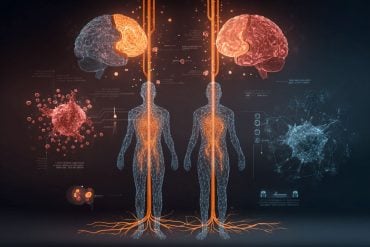Summary: Mice, like humans, navigate social hierarchies using subtle cues—but instead of reading facial expressions or clothing, they rely on chemical signals. A new study reveals that male mice can determine the social rank of unfamiliar opponents using airborne odors and physical scent cues.
In a tunnel confrontation test, mice either retreated or stood their ground depending on how they assessed the other mouse’s status relative to their own. Disabling both the olfactory and vomeronasal systems eliminated this ability, but knocking out just one did not, showing the systems compensate for each other.
Key Facts:
- Dual Sensory Systems: Mice use both olfactory (airborne) and vomeronasal (contact-based) cues to assess social status.
- Dynamic Processing: Social rank isn’t based on fixed behavior but inferred through real-time sensory integration.
- Human Parallel: Like mice, humans gauge social status of unfamiliar individuals using available sensory cues, especially in unfamiliar social settings.
Source: Francis Crick Institute
Like many mammals, mice live in a social hierarchy where some are more dominant than others. This helps to avoid conflict and establish breeding partners.
It has been suggested previously that some mice might display fixed behaviour regardless of who they are interacting with, or that physical properties can give cues about social ranking.

However, new research published today in Current Biology shows that mice instead infer an unfamiliar mouse’s rank through chemical cues transmitted in the air (odours) or through direct contact (non-volatile scent cues).
The Crick team worked this out using a test where male mice enter a transparent tube at opposite ends, meeting in the middle. In this type of confrontation, a more submissive animal will typically retreat.
The researchers first looked at interactions in mice who shared the same cage, using this to rank each mouse on a hierarchy, before observing how the mice responded to a set of unfamiliar opponents.
They found that the strangers could recognise each other’s rank, compare it to their own, and either retreat or force the other mouse to retreat.
The team then tested the mice in the dark, finding that this did not affect rank recognition, suggesting that cues like physical size or behaviour don’t determine recognition of a more aggressive opponent. Similarly, castrating the mice to remove their sex hormones had no impact.
Finally, the team experimentally blocked the two chemosensory systems that mice use – one for odours in the air (olfactory system) and one for chemical signals transmitted by physical contact (vomeronasal system).
They found no effect when just one of these systems was removed; both needed to be ablated before the mice couldn’t recognise opponent rank. This showed that mice use both olfactory and vomeronasal systems to recognise rank and can compensate if one is missing.
Like mice, people can also infer the social status of others around them relative to their own, also using sensory cues, including language, facial expression or clothing.
The next step for the researchers is to investigate which areas of the brain process the information on opponent rank and own rank and initiate a decision to retreat or advance.
Neven Borak, former PhD student in the State-Dependent Neural Processing Laboratory at the Crick and first author, said: “We’ve shown that mice weigh up strangers using chemical cues and can detect social status without needing an extensive history of confrontations with those specific opponents. This is a fascinating phenomenon that humans do too mostly using visual cues.
“Our work offers an interesting perspective on social mobility: humans, like mice, can enter a new group of people but still maintain understanding of own social rank and gauge the social status of unfamiliar people.”
Jonny Kohl, Group Leader of the State-Dependent Neural Processing Laboratory at the Crick and senior author, said: “We’ve shown for the first time how mice integrate internal and external information about dominance.
“This shows that a decision based on relative ranks is made in the brain before mice show either aggression or submissive behaviour, rather than there being fixed differences in behaviours leading to an aggressive or docile mouse.”
The State-Dependent Neural Processing Laboratory studies how processes within the brain are impacted by the state of the body.
By studying how physiological states, such as pregnancy, stress or sleep, impact neural circuits in mice, the researchers hope to advance a more integrative view of brain physiology in health and disease.
About this sensory and social neuroscience research news
Author: Clare Green
Source: Francis Crick Institute
Contact: Clare Green – Francis Crick Institute
Image: The image is credited to Neuroscience News
Original Research: Open access.
“Dominance rank inference in mice via chemosensation” by Neven Borak et al. Current Biology
Abstract
Dominance rank inference in mice via chemosensation
Social dominance hierarchies enable efficient resource allocation and conflict avoidance in animal communities.
Individuals can determine their relative status by tracking previous conflict outcomes, as seen in aggression training and the winner effect, where successive wins increase the likelihood of future victories.
Repeated optogenetic stimulation of the dorsomedial prefrontal cortex (dmPFC) results in lasting rank increases, suggesting that social rank is derived as a statistic of past outcomes.
However, relative rank could be assessed more efficiently by incorporating information about an opponent’s dominance status.
Pheromone signals, such as darcin, are enriched in the urine of dominant individuals, suggesting that hierarchical behavior may integrate information about both own and opponent rank.
Although prior studies have explored the learning and neural representation of own rank, how opponent rank is detected and encoded remains unclear.
Here, we address this question in male mice using a tube test assay.
We show that stable hierarchies do not rely on fixed behavioral traits and that mice can infer the rank of unfamiliar opponents by detecting scalable chemosensory rank cues.
Sensory ablation experiments reveal that both olfactory and vomeronasal cues are sufficient for rank assessment. Male mice thus use chemosensory signals to infer dominance status during social interactions.







